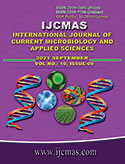


 National Academy of Agricultural Sciences (NAAS)
National Academy of Agricultural Sciences (NAAS)

|
PRINT ISSN : 2319-7692
Online ISSN : 2319-7706 Issues : 12 per year Publisher : Excellent Publishers Email : editorijcmas@gmail.com / submit@ijcmas.com Editor-in-chief: Dr.M.Prakash Index Copernicus ICV 2018: 95.39 NAAS RATING 2020: 5.38 |
Mobile phones of healthcare workers carry various micro-organisms. If pathogenic bacteria and resistant strains are isolated from mobile phones, they can be a potential threat in the spread of nosocomial infections. To study the microbial flora isolated from mobile phones of doctors and nurses and to isolate possible pathogens and detect resistant strains among them. 90 swabs were collected from mobile phones of healthcare workers (30 physicians, 30 surgeons and 30 nurses) and plated onto sheep blood agar and MacConkey agar. Bacterial isolates were identified by suitable biochemical reactions. Resistance patterns among pathogens were recorded. Out of 90 swabs, 72 (Physicians-30, Surgeons-24, Nurses-18) showed growth. Commonly isolated organisms were Micrococci (59%), Diphtheroids (23%), Staphylococcus aureus (7%), Coagulase negative Staphylococcus (5%), Enterococcus species (3%) and Klebsiella pneumoniae (3%). Out of 6 Staphylococcus aureus, 4 were Methicillin resistant, all of which were isolated from physicians. Mobile phones of nurses showed significantly lesser growth, as most of them do not use their mobile phones during work hours. Overall, most organisms isolated were normal flora and common contaminants, the incidence of pathogens being significantly low. So, the process of regular hand sanitization itself can control the spread of infection from mobile phones.
 |
 |
 |
 |
 |